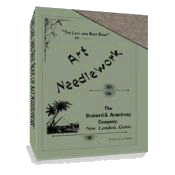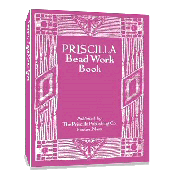Fancy Embroidery Stitches
Fancy embroidery stitches with instructions will supply those who desire to use the needle in the cause of home decoration, and those who take delight in making their homes beautiful, an opportunity to vary or increase their knowledge and efforts.
For your perusal are a number of fancy stitches with instructions which will help you create beautiful home decorations that will be loved and cherished for years to come.
The following information is from Beeton's Book of Needlework, edited for easy reading online.
Ladder Stitch | Button-hole Stitch Scallop | Button and Eyelet Holes | Shaded Button-hole | Variety of Leaf Stitches | Variety of Blossom Stitches | Star Pattern in Satin Stitch
Fancy Embroidery Stitches -
Ladder Stitch.
ILLUSTRATIONS 80 & 81. show the ladder stitch, often used in ornamental embroidery. Trace first the outlines as seen in illustrations; mark also the cross stitches between the outlines, so that the first touch the outlines only at both ends. The outlines are embroidered in overcast stitch or double overcast; the material is cut away underneath the ladder stitch between the outlines.


We have now shown the different kinds of stitches used in embroidery; the following illustrations show them used for different patterns.
Fancy Embroidery Stitches -
A Variety of Button-hole Stitches.
ILLUSTRATIONS 82 TO 85 (Different Button-hole Stitch Scallops).--These scallops are prepared as above described. Take care to have the stitches even and regular; the scallops must be wide in the centre and very fine at both ends.




ILLUSTRATIONS 86 & 87. (Button-holes and Eyelets).--This kind of embroidery stitch is used only in round or long patterns. Trace first the outline of the hole, cut away a small round piece of material, not too close to the outlines (when the button-hole is very small merely insert the point of the scissors or a stiletto into the material), fold the edge of the material back with the needle, and work the hole in overcast stitch, inserting the needle into the empty place in the centre and drawing it out under the outline. Some button-holes are worked separately; sometimes they are in a row; if so, take care to begin to work each button-hole at the place where it touches the next. In the following button-holes the outside must be traced double, so as to reach as far as the next one, but each button-hole is finished at once. Illustration 86 shows a button-hole worked round in button-hole stitch, 87 an eyelet-hole worked in overcast.


ILLUSTRATIONS 88 & 89.-- Shaded button-holes are worked like the others, only they are prepared, as can be seen in illustration 89, so as to mark the thickness. The embroidery stitches must gradually get narrower or wider, and be worked very close to each other.


Fancy Embroidery Stitches -
A Variety of Leaf Stitches.
ILLUSTRATIONS 90 & 91. (Two Leaves in Raised Satin Stitch).--In a leaf like the one seen in 90 work first the outline and veining in overcast stitch; work one half of the leaf in satin stitch, and the other half between the overcast outline and veining in back stitch. The stem of a leaf is always worked last.


ILLUSTRATIONS 92 & 93 (Two Leaves in Satin Stitch and Point de Plume).--For leaves like the one seen in 93 begin with the veinings, then work the inner points, then the outer ones, and lastly the raised spots in the centre. The leaf seen in 92 is worked, one half in point de plume, the other half in back stitch or point d'or.


ILLUSTRATION 94.--- The outline of this leaf is embroidered in overcast stitch; the open-work veining consists of eyelets; one half of the leaf is worked in back stitch, the other half in a kind of satin stitch worked without chain stitches underneath; the stitches are worked across the leaf, leaving between two stitches an interval as wide as the stitch itself. The next row is then worked in these intervals, and each embroidery stitch begins half-way up the one before and after it.

ILLUSTRATIONS 95 to 97 (Leaf in Raised Embroidery).--This kind of embroidery stitch is particularly beautiful, as it is worked separately and sewn on the material with an outline in very fine cotton, this produces the shade seen in 95 (see also illustrations 98 to 113). For such leaves work first one half in overcast and satin stitch (illustration 96); the other half is worked on a separate piece of material (see illustration 97); cut away the material along the overcast outline, and fasten it on the foundation material along the outline which forms the veining on illustration 96.



ILLUSTRATIONS 98 TO 100 show a similar leaf; both halves are worked separately (see 99); the centre is worked in open lace stitch. The latter (see No. 100) is traced, then make ladder stitches across, work the outlines in overcast stitch, and cut away the material underneath the ladder stitch. The cross stitches are then worked in darning stitch with very fine cotton wherever two threads meet.



Fancy Embroidery Stitches -
A Variety of Blossom Stitches.
ILLUSTRATION 101 (Blossom in Satin Stitch).--The eyelet is worked in overcast stitch, then work the upper part of the blossom all in one piece as far as the beginning of the veining, thence the blossom is worked in two halves.

ILLUSTRATIONS 102 & 103 (Blossom in Satin Stitch).--The raised centre of this flower is formed by a bead, over which the embroidery is worked. When the leaves have been worked one after the other, place a bead in the centre, left free in such a manner that one hole lies on the material, and work over the bead by inserting the needle into its upper hole, then underneath the material, drawing it out above the material close to the bead, and so on (see 103).


ILLUSTRATION 104 (Star Pattern in Satin Stitch).--The centre, which forms a wheel, is worked first. Draw the threads across the circle marked by an outline; in the centre they are wound round, always taking one thread on the needle and leaving the next thread under the needle, as can be seen in 122 on the half-finished pattern. The material underneath the wheel is only cut away when the rest of the pattern has been embroidered.

ILLUSTRATIONS 105 & 106 (Patterns in Back, Satin, and Ladder Stitches).--The small star in the centre of No. 105 is worked in point de reprise.

These fancy embroidery stitches may take time and practice but the results are well worth it. What amazing designs can come from using them!
Click on more fancy embroidery stitches for great instructions and illustrations on flowers and other botanicals.
Peruse the Embroidery Instructions to see the best of the best embroidery stitches. Stitches are added from time to time. Make sure you haven't missed any!
Return to Fancy Embroidery Stitches Top.
The Last and Best Book of Art Needlework
Over 100 pages of authentic Victorian instructions and patterns from 1895!
FREE
Beeton's Book Of Needlework

433 pages!
Sign up for VEAC! Everything you wanted to know about Victorian embroidery, needlework, crafts and more!
Priscilla Bead Work Book
Make Beautiful Victorian Beaded Purses, Jewelry & Accessories - Starting
TODAY!



